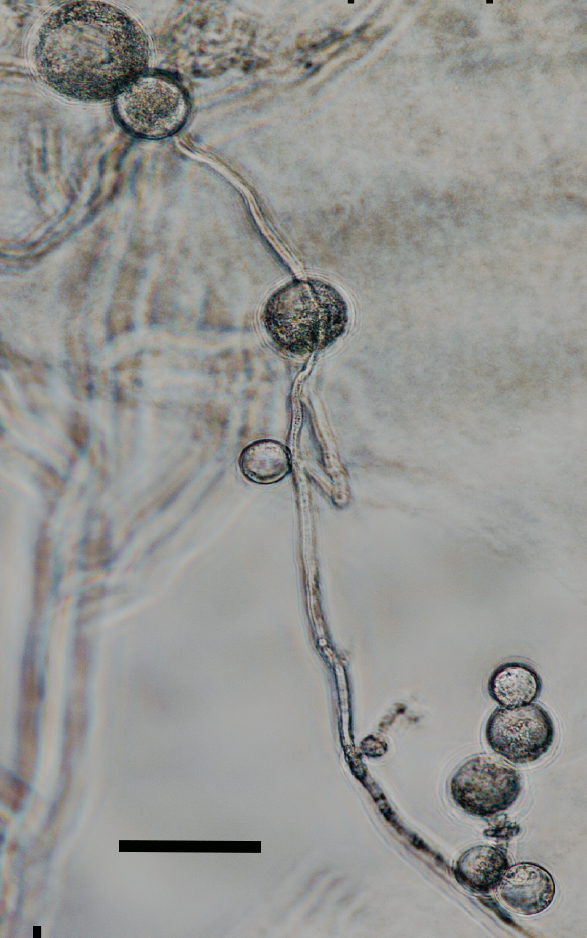Phytophthora afrocarpa
|
Phytophthora spp. in subclade 10b: portion of the seven-loci ML phylogeny featuring the type cultures of 212 described species (by T. Bourret). Notice the position of P. afrocarpa Ex-type CBS 147467 = S&T BL 204. Gloria Abad, USDA S&T.
|
|
Phytophthora spp. in subclade 10b: Morphological Tabular key (PDF) and Tabular key legends (PDF) in IDphy2 KEY SECTION. Notice the data of P. afrocarpa Ex-type CBS 147467 = S&T BL 204. Gloria Abad, USDA S&T.
|
|
persistent, non-papillate, predominantly ovoid sporangia exhibiting internal extended proliferation; scale bar = 20µm |
|
catenulate and solitary chlamydospores; scale bar = 20µm |
Name and publication
Phytophthora afrocarpa T. Bose & J.M. Hulbert (2021)
Bose T, Hulbert JM, Burgess TI, Paap T, Roets F, Wingfield MJ. 2021. Two novel Phytophthora species from the southern tip of Africa. Mycological Progress 20 (6): 755–767.
Corresponding author: Tanay Bose; Tanay.Bose@fabi.up.ac.za
Nomenclature
Mycobank
Etymology
name refers to the tree Afrocarpus falcatus (syn. Podocarpus falcatus) from which the isolates were recovered
Typification
Type: SOUTH AFRICA, Diepwalle Forest, Western Cape Province, from rhizosphere soil of Afrocarpus falcatus (− 33.956555, 23.152709), January 2017, JM Hulbert, holotype PREM63082
Ex-type: culture PPRI 28450 = CMW 54630 = CBS 147467
Sequences of ex-type in manuscript: ITS MT762306, ß-tubulin MT762324, HSP90 MT762333, coxI MT762315
Ex-type in other collections
(ET) CBS 147467, NRRL 64331, PPRI28450, CMW54630, S&T BL 204 (Abad)
Molecular identification
Voucher sequences for barcoding genes (ITS rDNA and COI) of the ex-type (see Molecular protocols page)
Phytophthora afrocarpa ITS rDNA, COI
Voucher sequences for Molecular Toolbox with seven genes (ITS, β-tub, COI, EF1α, HSP90, L10, and YPT1
(see Molecular protocols page) (In Progress)
Voucher sequences for Metabarcoding High-throughput Sequencing (HTS) Technologies [Molecular Operational Taxonomic Unit (MOTU)]
(see Molecular protocols page) (In Progress)
Sequences with multiple genes for ex-type in other sources
- NCBI: Phytophthora afrocarpa
- EPPO-Q-bank: Phytophthora afrocarpa
- BOLDSYSTEMS: Phytophthora afrocarpa
Position in multigenic phylogeny with 7 genes (ITS, β-tub, COI, EF1α, HSP90, L10, and YPT1)
Clade clade:
a taxonomic group of organisms classified together on the basis of homologous features traced to a common ancestor
10b
Morphological identification
Colonies and cardinal temperatures
Slow growing species with cottony, chrysanthemum pattern on CA and V8A, stellate on PDA, and immersed on MEA. Minimum growth temperature 4°C, optimum 25°C, and maximum 30°C.
Conditions for growth and sporulation
SporangiaSporangia:
sac within which zoospores form, especially when water is cooled to about 10°C below ambient temperature; in solid substrates, sporangia usually germinate by germ tubes
are produced in water cultures (soil extract) and not observed in solid media. OogoniaOogonia:
the female gametangium in which the oospore forms after fertilization by the antheridium
not produced in single or paired cultures.
Asexual phase
SporangiaSporangia:
sac within which zoospores form, especially when water is cooled to about 10°C below ambient temperature; in solid substrates, sporangia usually germinate by germ tubes
were non-papillate, persistentpersistent:
pertaining to sporangia that remain attached to the sporangiophore and do not separate or detach easily (cf. caducous)
, and predominantly ovoidovoid:
egg-shaped, with the widest part at the base of the sporangium and the narrow part at the apex
to elongated ovoidovoid:
egg-shaped, with the widest part at the base of the sporangium and the narrow part at the apex
in shape with internal extended proliferationextended proliferation:
a type of internal proliferation in which the sporangiophore originates from inside of an empty sporangium, and continues to grow through and out of the old sporangium
. SporangiaSporangia:
sac within which zoospores form, especially when water is cooled to about 10°C below ambient temperature; in solid substrates, sporangia usually germinate by germ tubes
averaged 28 x 18.6 µm (overall range 13.3–49.5 x 7.4–31.2 µm). Sporangiophores simple.Hyphal swellings present. ChlamydosporesChlamydospores:
an asexual spore with a thickened inner wall that is delimited from the mycelium by a septum; may be terminal or intercalary, and survives for long periods in soil
present.
Sexual phase
Sterile in culture.
Most typical characters
Phytophthora afrocarpa is a sister species to P. gallica in cladeclade:
a taxonomic group of organisms classified together on the basis of homologous features traced to a common ancestor
10. Both species are sterile in culture, but differ in other morphological features.
Specimen(s) evaluated
South Africa, Diepwalle Forest, Western Cape Province, from rhizosphere soil of Afrocarpus falcatus, 2017, JM Hulbert, CBS 147467; CBS 147590; CBS 147468
Hosts and distribution
Distribution: South Africa
Substrate: roots
Disease note: no diseases recorded
Hosts: Afrocarpus falcatus
Additional references and links
- SMML USDA-ARS: Phytophthora afrocarpa
- EPPO Global Database: Phytophthora afrocarpa
- Forest Phytophthoras of the World: Phytophthora afrocarpa
- CABI Digital Library: Phytophthora afrocarpa
- Encyclopedia of Life (EOL): Phytophthora afrocarpa
- Index Fungorum (IF): Phytophthora afrocarpa
Fact sheet author
Treena Burgess, Ph.D., Phytophthora Science and Management, Harry Butler Institute, Murdoch University, Australia
Z. Gloria Abad, Ph.D., USDA-APHIS-PPQ-S&T Plant Pathogen Confirmatory Diagnostics Laboratory (PPCDL), United States of America.



